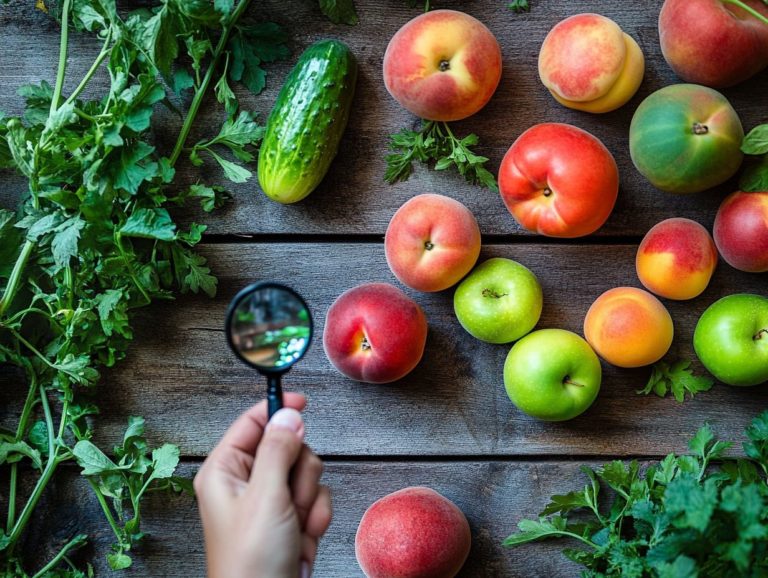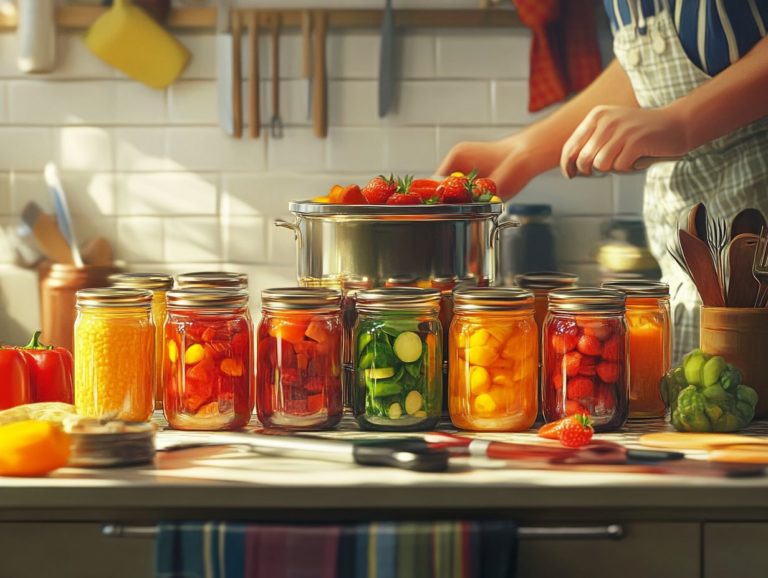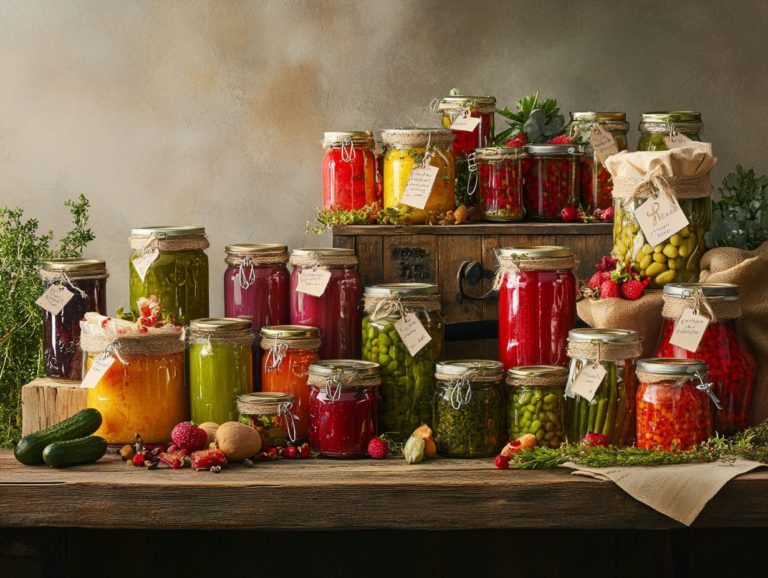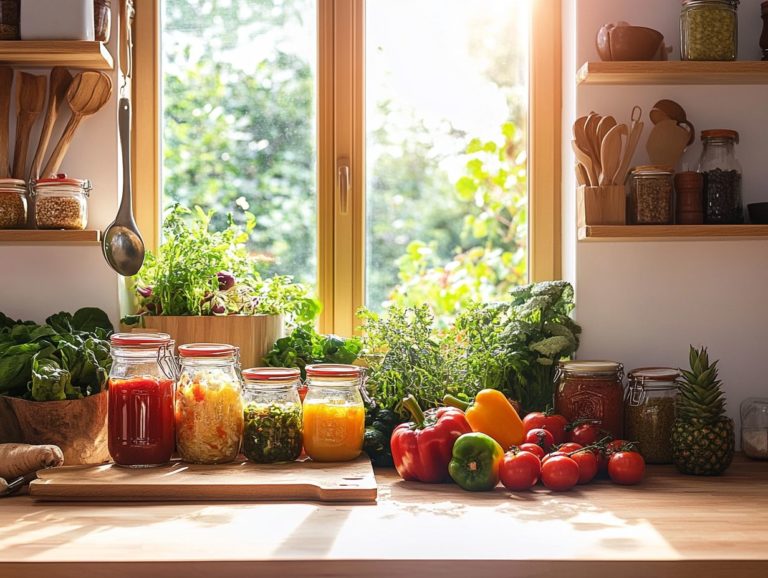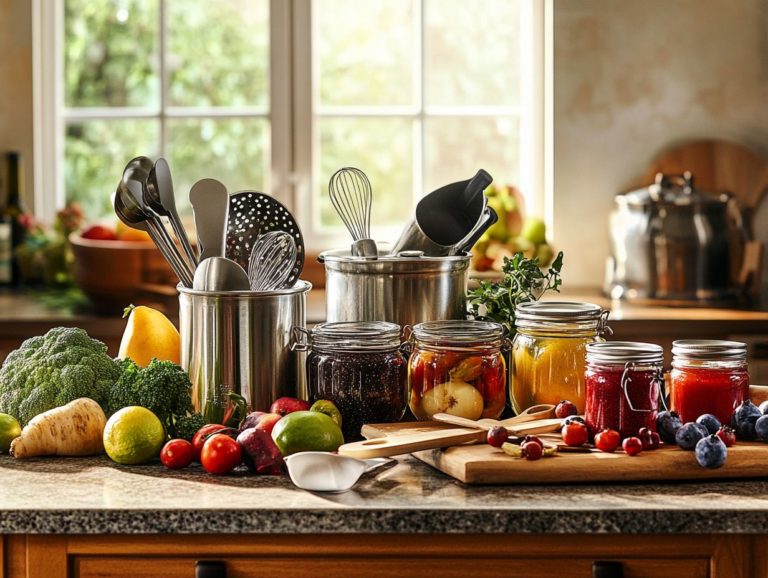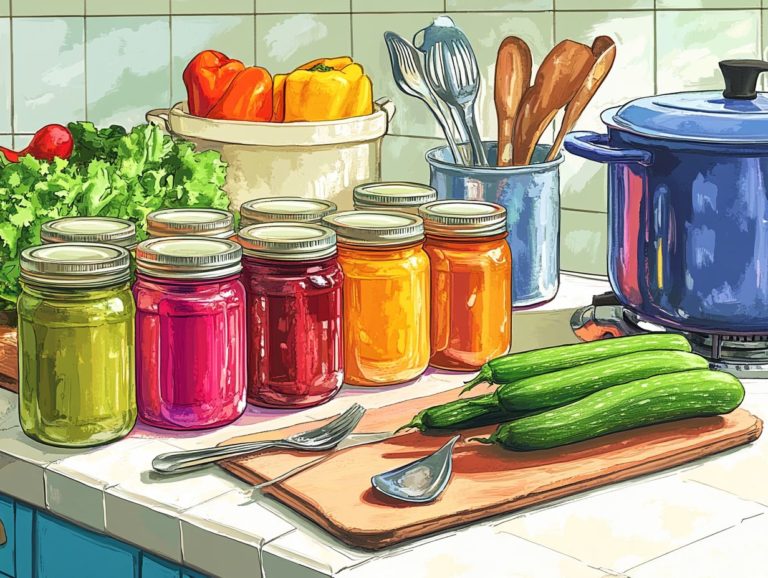5 Common Canning Myths Debunked
Canning is frequently surrounded by misconceptions and canning myths that could easily dissuade even the most daring home cooks. You may think canning is only for expert cooks, but that s not true! You might believe it s an endeavor meant solely for seasoned chefs or that you need a trove of special equipment to get started. These myths can hold you back from experiencing the myriad benefits of this timeless food preservation method. Get ready to dive into the exciting world of canning!
In this article, you ll uncover five common canning myths, delve into how the process works, and examine the nutritional value and safety of canned foods.
Contents
- Key Takeaways:
- 1. Canning Is Only for Experienced Cooks
- 2. You Need Special Equipment to Can
- 3. Canned Foods Are Not Nutritious
- 4. Canning Is Only for Fruits and Vegetables
- 5. Canned Foods Have a Long Shelf Life
- How Does Canning Actually Work?
- What Are the Benefits of Canning Food at Home?
- What Are the Different Methods of Canning?
- What Foods Can Be Canned?
- What Are the Safety Precautions to Keep in Mind When Canning?
- What Are Some Common Mistakes to Avoid When Canning?
- How Can You Tell If Canned Food Has Spoiled?
- Can Canning Be a Sustainable Practice?
- What Are Some Creative Ways to Use Canned Foods?
- How Can Canning Help Reduce Food Waste?
- Frequently Asked Questions
Key Takeaways:
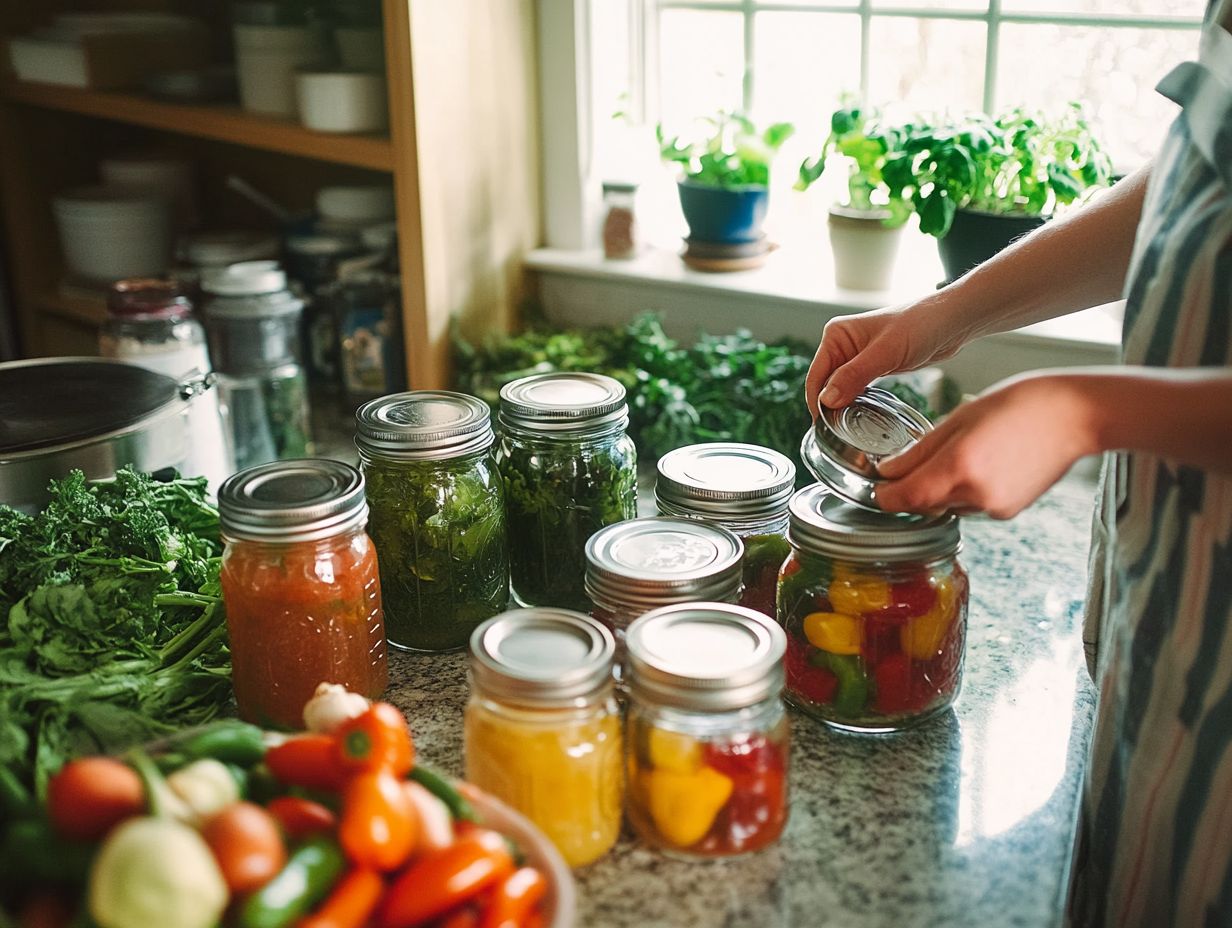
- Canning is not just for experienced cooks – anyone can learn how to safely can food at home.
- You do not need special equipment to can – basic kitchen tools can be used to start canning at home.
- Canned foods can be nutritious and provide important nutrients, especially when preserving seasonal produce during peak seasons.
1. Canning Is Only for Experienced Cooks
Canning is often mistakenly viewed as a technique reserved for seasoned chefs, but with the right guidance from trusted sources like the WVU Extension Service and expert advice from professionals such as Gina Taylor, you can master safe canning practices to effectively preserve your seasonal bounty. For those new to canning, it’s helpful to refer to 5 frequently asked canning troubleshooting questions. This process not only enhances food safety by preventing foodborne illnesses but also significantly reduces the risk of botulism, making it an invaluable skill for cooks of all levels.
Beginner-friendly resources simplify the canning process, offering step-by-step instructions that make it accessible, even for those just starting out. Many new canners harbor concerns about its complexity or safety; however, these worries often arise from old misconceptions. By focusing on essential food safety guidelines like using sterilized jars and understanding the right temperature needed to eliminate botulism spores, these resources help you step confidently into the world of canning. Additionally, if you encounter issues, check out common canning problems and solutions for helpful tips.
With the right education and understanding, you can embrace the joy of preserving your favorite flavors while ensuring that the highest safety standards are met.
2. You Need Special Equipment to Can
While it’s true that certain canning techniques necessitate specific equipment like a pressure canner for low-acid foods or a boiling water bath for high-acid ones you can embark on your canning journey with just the basics: clean jars and lids. A pressure canner uses steam under pressure to preserve foods, while a boiling water bath involves submerging jars in boiling water.
In fact, you can execute a variety of canning techniques with minimal tools, debunking the notion that you need high-priced gear for successful preservation. For those concerned about safety, it’s important to understand is home canning safe? Simple items such as a large pot, a long-handled spoon, and a funnel can make the process smooth and affordable.
Don t overlook the importance of altitude adjustments, either. They can significantly influence cooking times and pressure levels, ensuring your jars seal properly. Proper jar sealing not only keeps your food safe for long-term storage but also preserves the rich flavors of your home-grown produce, making all your efforts truly worthwhile.
3. Canned Foods Are Not Nutritious
Canned foods often find themselves under a critical lens when it comes to nutritional value; however, when done right, canning serves as an excellent method for preserving the nutrient retention of seasonal produce. This makes it a savvy choice for healthy eating all year round and supports community development through access to healthy foods.
The canning process swiftly seals and heats fresh fruits and vegetables, effectively eliminating harmful bacteria while locking in essential vitamins and minerals that might otherwise degrade during storage. When you compare canned options to their fresh and frozen counterparts, which can slowly lose nutrients due to exposure to air and light, you’ll discover that canned foods can actually maintain, or even enhance, their nutritional profile, making them a healthy choice.
Embracing seasonal eating amplifies this benefit, allowing you to savor produce at its peak ripeness and nutrient density. This approach leads to a more flavorful and nourishing diet, even during the off-season, ensuring you enjoy the best nature has to offer throughout the year.
So why wait? Start your canning journey today!
4. Canning Is Only for Fruits and Vegetables
The misconception that canning is only about fruits and vegetables fails to recognize the incredible variety of foods you can preserve. Think beyond the basics; high-acid foods like tomatoes and an array of low-acid foods open up a world of culinary delights.
You can safely can meats such as chicken and beef. This allows you to whip up delicious stews or hearty soups at a moment s notice.
Homemade sauces, like marinara or barbecue, not only elevate your meals but also serve as excellent candidates for preservation. Imagine creating a simple salsa recipe with tomatoes, onions, and peppers, resulting in a zesty addition to any dish.
To ensure safety in your canning adventures, it s crucial to adhere to recommended guidelines. Using a pressure canner for low-acid foods ensures safety while keeping your family healthy and enjoying a rich variety of preserved foods.
5. Canned Foods Have a Long Shelf Life
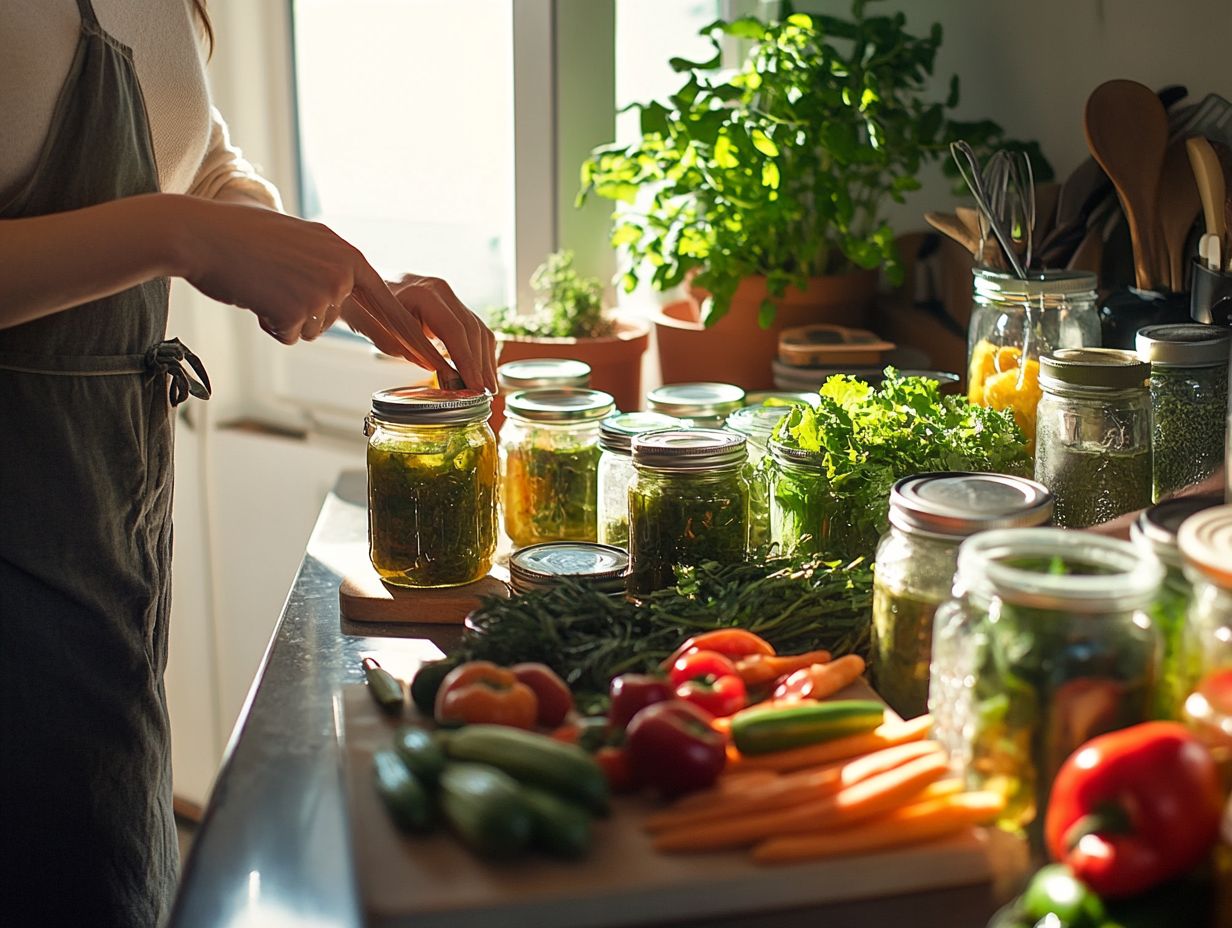
One of the standout benefits of canned foods is their impressive shelf life. This makes food storage a breeze and assists food banks in providing nutritious options for those in need.
It’s essential to recognize that this longevity can be influenced by several factors. These include proper sealing techniques and optimal storage conditions.
When the canning process guarantees an airtight seal, it effectively prevents spoilage and contamination. This extends the food’s edibility.
If you store canned goods in a warm, humid environment or if the seal is compromised, you increase the risk of bacterial growth. This can lead to health hazards.
Understanding these elements is crucial if you’re aiming to maximize the shelf life of your canned foods. This helps minimize the risk of foodborne illnesses.
How Does Canning Actually Work?
The canning process is all about preserving food by sealing it in jars or containers. The method varies based on whether you use a boiling water bath for high-acid foods or a pressure canner for low-acid ones.
This creates a vacuum seal that prevents spoilage and enhances food preservation. Understanding the specific details of these canning methods is crucial for your cooking safety.
For example, acidification means lowering the pH, which helps prevent bacteria growth. This is key in the canning process, especially for high-acid foods like fruits and pickles.
Conversely, low-acid foods such as vegetables and meats demand higher temperatures that pressure canning provides to eliminate harmful microorganisms. Following precise recipes and guidelines from reputable sources like the National Center for Home Food Preservation is essential for safe canning practices.
These established protocols ensure your food is processed safely. This reduces the risk of foodborne illnesses while preserving the quality and flavor of your canned goods.
What Are the Benefits of Canning Food at Home?
Canning food at home presents you with a wealth of benefits. You can maximize the nutrient retention of seasonal produce and foster community development through shared skills and resources.
By choosing fresh fruits and vegetables from local farmers markets, you indulge in superior flavors. This also supports regional agriculture and local food banks.
This practice encourages meaningful relationships between you and local growers. It ensures that farmers can thrive economically.
Engaging in home canning significantly reduces food waste and minimizes your carbon footprint. You can preserve excess produce that might otherwise go unsold.
As you fill your pantry with homemade goods, you contribute to a more resilient food system. Start canning today to enjoy fresh flavors all year round!
What Are the Different Methods of Canning?
Canning comes in two main types: pressure canning for low-acid foods and boiling water bath for high-acid foods. Each requires specific techniques to keep your food safe!
Understanding the difference between these methods is essential, as they cater to varying acidity levels in foods, which significantly affects preservation. For low-acid foods like vegetables, meats, and poultry, pressure canning is your go-to method. This technique reaches the high temperatures needed to eliminate harmful bacteria, including the notorious botulism risk. Prepare your clean jars, fill them with food and liquid, seal them properly, and process them in a pressure canner for the time specified in trusted recipes.
On the other hand, the boiling water bath method is perfect for high-acid foods like fruits and pickles and is a safe canning technique for beginners. This straightforward process involves filling your jars, securing the lids, and submerging them in boiling water for the required time.
By following detailed, tested recipes, you not only achieve delicious results but also protect yourself against foodborne illnesses. Home canning can be a joy that is both safe and satisfying!
What Foods Can Be Canned?
You can preserve a wide variety of foods! High-acid items like tomatoes and fruits are great, while low-acid staples include vegetables and meats. This versatility makes canning an exceptional method for preserving different ingredients.
Understanding the distinctions between these categories is crucial for your canning success. High-acid foods typically have a pH below 4.6, which is low enough to inhibit harmful bacteria. This category includes not just tomatoes and citrus fruits but also pickled items and berries. In contrast, low-acid foods like green beans, corn, and meats require specific processing methods to ensure safety.
When choosing produce for canning, opting for the freshest ingredients is paramount. This enhances flavor and improves texture in your final product. Look for vibrant colors and firm, blemish-free produce to achieve outstanding results, ensuring your canned goods remain delightful long after the harvest.
What Are the Safety Precautions to Keep in Mind When Canning?
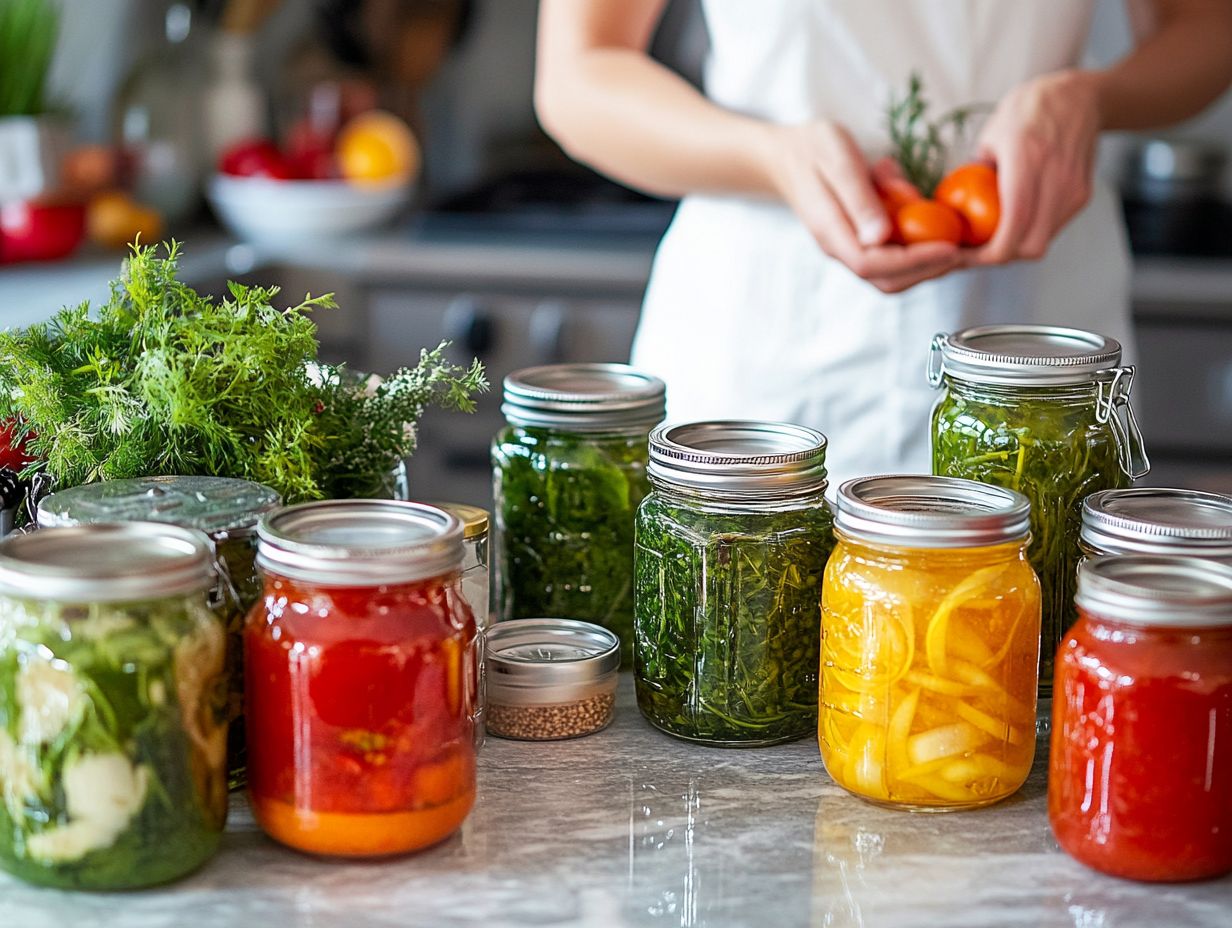
When you embark on the canning journey, it’s vital to follow strict safety precautions to minimize the risk of botulism. To learn more about ensuring success, check out tips on avoiding common canning errors. Use clean jars, ensure proper sealing, and make necessary altitude adjustments for successful preservation.
Also, verify that your equipment such as pressure canners and thermometers is functioning correctly and calibrated. This attention to detail can save you from mishaps during the process.
Relying on tested recipes is crucial; they provide the necessary guidance on processing times and temperatures to ensure your food is safely preserved. It’s important to debunk common myths surrounding canning, like the idea that slight deviations from recommended practices are acceptable.
Experts stress that such assumptions can lead to serious food safety issues. By adhering to established guidelines and seeking expert advice, you can confidently engage in these delightful preservation methods. For instance, learning how to avoid common canning mistakes can help ensure you do not compromise safety.
What Are Some Common Mistakes to Avoid When Canning?
New canners often make mistakes that can compromise food safety! This can happen due to improper recipe adherence, overlooking health risks tied to incorrect canning techniques, or falling for canning equipment myths related to food safety.
These pitfalls frequently arise from insufficient processing times, which can lead to spoilage or pose a risk of dangerous foodborne illnesses. Improper jar sealing can also compromise the airtight environment crucial for preservation.
For those starting their canning journey, it s essential to utilize tested recipes and follow them meticulously, paying close attention to the recommended processing times for each specific food type.
Confirming that jars are sealed correctly by checking the lids and using the right equipment can further ensure the safety and longevity of your preserved goods. By following these safe canning standards, you can savor the fruits of your labor with confidence and peace of mind!
How Can You Tell If Canned Food Has Spoiled?
Identifying spoiled canned food is essential for safety. Look for signs like bulging lids or off-putting smells when you open a can.
In addition to these clues, be on the lookout for discoloration or unusual textures, such as mold or a thickened consistency. If anything seems off, it’s safer to throw it away.
If you spot any of these signs, it’s best to discard those cans. Proper food storage is key to preventing spoilage. Always keep your canned goods in a cool, dry place, and periodically check your pantry items to ensure they are still safe for consumption.
Can Canning Be a Sustainable Practice?
Canning can be a truly sustainable practice. It minimizes food waste by preserving seasonal produce while fostering community development through shared knowledge and resources.
This method prevents spoilage that often occurs when surplus harvests are left to rot. Local economies benefit from community canning initiatives, encouraging you to buy fresh, locally sourced ingredients.
Organizations like community canning kitchens teach you the art of preserving while promoting local farms and markets.
These projects inspire collective action and strengthen community ties, ultimately supporting sustainable food systems and nurturing local resilience.
What Are Some Creative Ways to Use Canned Foods?
Canned foods hold endless potential for your kitchen! Transform simple meal ideas into exciting dishes that make the most of your preserved ingredients.
With their remarkable shelf life and convenience, these budget-friendly staples can serve as the backbone of a multitude of dishes that satisfy any taste. For instance, experiment with canned beans to craft a robust chili or blend in some canned tomatoes for a zesty pasta sauce.
Even canned fruits can take center stage in your desserts or breakfast delights, like refreshing yogurt parfaits. Embrace the challenge of thinking outside the box and discover how these readily available items can elevate your stir-fries, casseroles, or even rustic breads.
The possibilities are truly endless. So, what will you create next? Open a can and get cooking!
How Can Canning Help Reduce Food Waste?
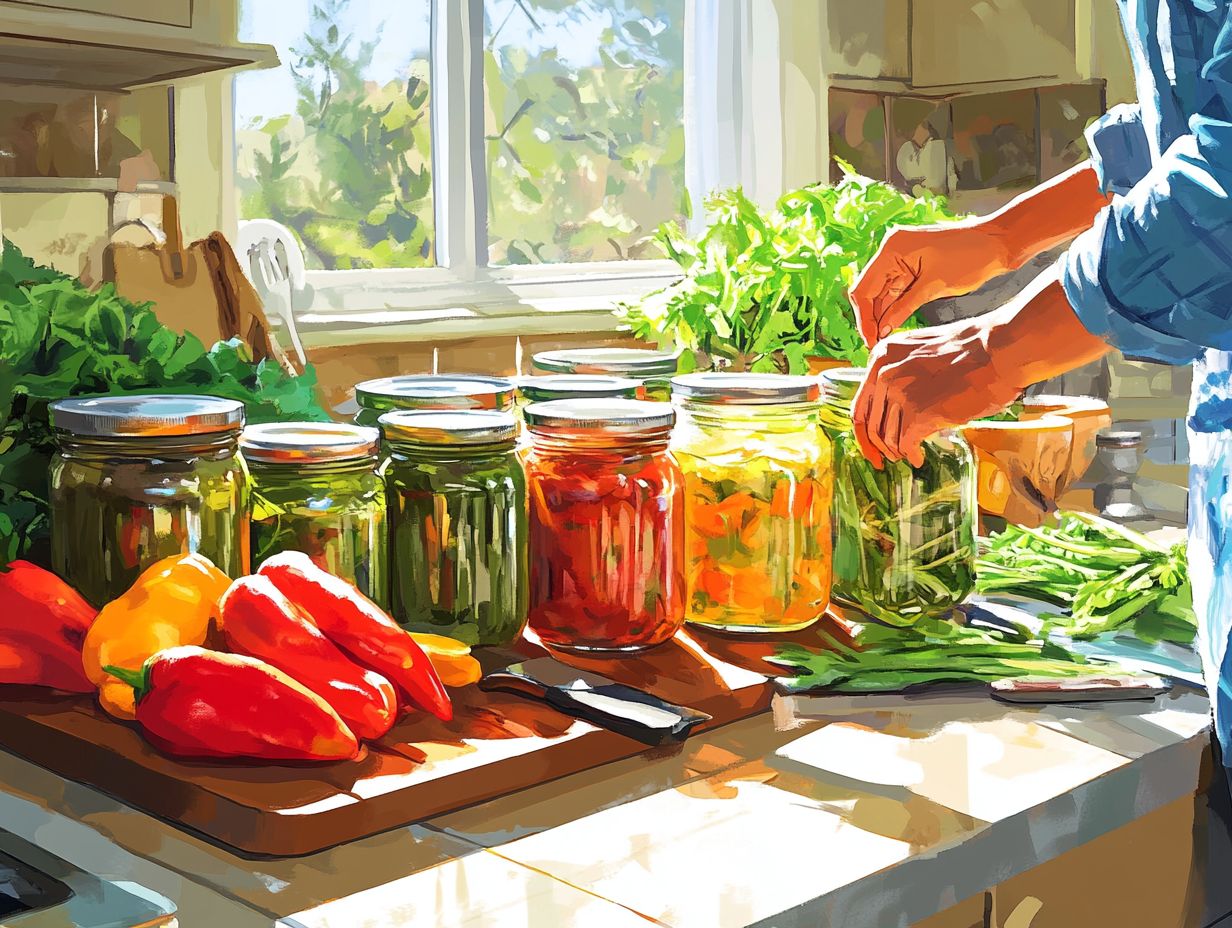
Canning stands out as an exceptional strategy for reducing food waste by preserving your harvests at their peak. This allows you and local food banks to make the most of surplus seasonal produce throughout the year.
Not only does this practice minimize spoilage of excess fruits and vegetables, but it also supports local farmers and communities by providing them with a valuable outlet for their crops. Engaging with canning initiatives and programs enables you to contribute to a more sustainable food system.
Workshops designed to teach canning techniques inspire you to connect with your locally sourced food and reduce your reliance on imported products while fostering a sense of community.
Collectively, these efforts lead to a healthier planet and enable you to take control of your food supplies, ensuring far less produce rots and goes to waste.
Frequently Asked Questions
What are the most common canning myths?
Many people believe that a pressure canner is necessary for all foods, but this is just one of several canning myths debunked.
Is it true that you can t can food without a pressure canner?
No, this is a common misconception. While pressure canners are best for low-acid foods, such as vegetables and meats, high-acid foods like fruits and tomatoes can be safely canned using a water bath canner.
Do I really need to sterilize my jars before canning?
Sterilizing your jars is crucial for safe and delicious canning. You can easily do this by boiling them in hot water or using your dishwasher.
Can I reuse lids when canning?
No, always use new lids for canning! Reusing lids can create a bad seal, leading to spoilage.
Is it safe to can food indefinitely?
No, to enjoy the best quality, consume your canned food within a year! While it might not be harmful to eat it after a year, the taste and quality will be worse.
Can I stack jars on top of each other in a canner?
No, stacking jars in a canner is unsafe. It causes uneven heating, which can lead to under-processing. Follow the spacing guidelines in your canning recipes!

